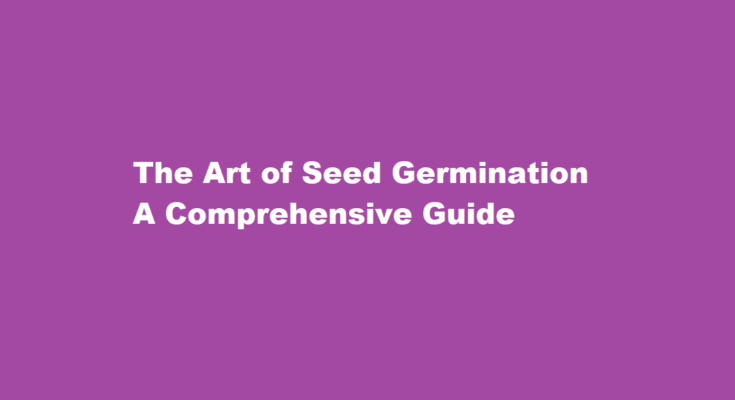Introduction
Seed germination is a fascinating process that marks the beginning of a plant’s life cycle. Whether you’re a seasoned gardener or a beginner, understanding the art of seed germination is essential for successful plant propagation. In this article, we will explore the key steps and factors involved in germinating seeds, providing you with valuable insights and practical tips to ensure your seeds sprout and thrive.
Seed Selection
Choosing high-quality seeds is crucial for successful germination. Opt for fresh seeds that are within their expiry date and obtained from reputable sources. Additionally, consider the specific requirements of each plant species and select seeds suitable for your growing conditions. Some seeds require stratification (exposure to cold temperatures) or scarification (nicking the seed coat) to enhance germination. Always read the seed packets or conduct thorough research to understand the specific needs of the seeds you’re working with.
Preparing the Germination Environment
Creating the ideal germination environment is vital to give your seeds the best start. Start by selecting an appropriate growing medium, such as seed-starting mix or sterile potting soil. Fill clean containers with the chosen medium, ensuring good drainage. Moisten the medium before sowing the seeds to provide the necessary moisture. Temperature and light are also critical factors. Most seeds germinate best at temperatures between 65°F and 75°F (18°C and 24°C). Some seeds require darkness, while others need light to germinate. Research the specific requirements for the seeds you are working with to provide optimal conditions.
Sowing Techniques
When sowing seeds, it’s essential to follow proper techniques to promote successful germination. Begin by making small holes or furrows in the planting medium at the recommended depth for the particular seeds. Sow the seeds evenly, making sure not to overcrowd the container. Cover the seeds gently with a thin layer of soil or vermiculite, considering the seed size and recommended planting depth. After sowing, gently water the container, using a misting spray or a fine sprinkler to avoid displacing the seeds. Maintaining moisture is crucial throughout the germination process.
Providing Adequate Moisture
Moisture is a critical factor in seed germination. To keep the seeds properly hydrated, mist the soil surface regularly or cover the container with a clear plastic wrap to create a greenhouse-like environment. Check the moisture level frequently and ensure the soil remains consistently moist but not waterlogged. Avoid overwatering, as it can lead to fungal diseases or rotting of the seeds. Consider using a spray bottle or a bottom-watering technique to provide moisture while minimizing the risk of disturbance to the seeds.
Temperature and Light Control
Most seeds require specific temperature ranges for successful germination. A consistent temperature within the ideal range is crucial to trigger seed activation and growth. Consider using a seedling heat mat or placing the containers in a warm area to maintain stable temperatures. Additionally, light requirements differ among various seeds. Some seeds require darkness for germination, while others need exposure to light. Ensure you understand the light requirements for the seeds you’re working with and provide the appropriate conditions. If additional light is needed, fluorescent grow lights or LED lamps can be utilized to provide the necessary illumination.
Patience and Monitoring
Germination can take anywhere from a few days to several weeks, depending on the plant species. It’s essential to practice patience and resist the temptation to disturb the seeds or adjust the germination conditions excessively. Regularly monitor the containers for any signs of sprouting, mold, or pests. Adjust the watering and environmental conditions as necessary. Maintaining a consistent, nurturing environment will give your seeds the best chance to germinate successfully.
FREQUENTLY ASKED QUESTIONS
What helps seeds germinate faster?
This method could be the fastest way to germinate seeds. Place seeds in a shallow container in warm water and leave them for 16 to 24 hours (smaller for 16, bigger for 24). Remember not to expose seeds to temperatures higher than 80°F (26.6°C) and not to pre-soak seeds for more than 24 hours.
What boosts germination?
The three primary factors that regulate seed germination are moisture, temperature, and oxygen. Light is also an important influence on germination in some species. Moisture in adequate amounts, as stated above, is critical during germination and seedling growth.
Conclusion
Seed germination is a delicate and exciting process that requires attention to detail and proper care. By selecting high-quality seeds, providing optimal growing conditions, and closely monitoring the germination process, you can greatly increase your chances of success. Remember to research the specific requirements of the seeds you’re working with, as each plant species may have unique needs. With patience and dedication, you can unlock the wonders of seed germination and embark on a rewarding gardening journey.
Read Also : Mastering The Art of Hostage Rescue in Counter-Strike Global Offensive



